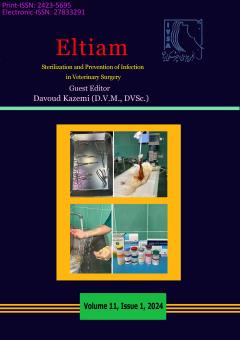Surgical site infections: classification and prevention methods
Subject Areas : Veterinary Soft and Hard Tissue Surgery
1 -
Keywords: Surgical site infections, Wound contamination, Risk factors, Preventive strategies,
Abstract :
Background: A review of surgical site infections in surgery
Objectives: Definition of surgical site infections and methods of diagnosis, treatment and prevention
Methods: A literature review using various publications related to surgical site infections
Results: Surgical site infections are defined as infections that occur at the surgical incision or deeper tissues of the surgical site in a certain period of time following surgery. These infections lead to increased morbidity, mortality, hospitalization, re-admission rates, post-discharge care and costs of surgery. Bacterial contamination of the incision site is the most important cause of these infections. Surgical site infections are divided into three categories based on the depth and type of infected tissue: superficial incisional infections, deep incisional infections, and infections related to organs or internal spaces of the body. Various patient-related and procedure-related factors are involved as risk factors of these infections. Diagnosis of surgical site infections is based on patient history and results of clinical examination, surgical wound evaluation, and laboratory tests. Wound management and judicious use of antibiotics according to the type of bacteria involved in the infection are considered as the two most important aspects of treatment plan. Prevention is the best strategy to deal with surgical site infections. Prevention strategies are divided into preoperative, intraoperative, and postoperative methods. The purpose of these measures is to prevent surgical wound contamination and increase patient resistance against infection. Accurate patient selection, adherence to aseptic principles, use of appropriate surgical technique, and complete aftercare of the patient and surgical wound, along with prophylactic use of antibiotic drugs, are the most important preventive measures against surgical site infections. Classification of surgical site infections, their etiology, risk factors, diagnosis and treatment methods and preventive measures are discussed in this review article.
Conclusions: After defining various types of surgical site infections, different methods of diagnosis, treatment and prevention are discussed and it is concluded that preventive strategies are the ideal method to control surgical site infections.
1. Owens CD, Stoessel K. Surgical site infections: epidemiology, microbiology and prevention. Journal of Hospital Infection. 2008; 70 (S2): 3-10.
2. Khan FU, Khan Z, Ahmed N, Rehman AU. A general overview of incidence, associated risk factors, and treatment outcomes of surgical site infections. Indian Journal of Surgery. 2020; 82: 449-459. https://doi.org/10.1007/s12262-020-02071-8
3. Gillespie BM, Harbeck E, Rattray M, Liang R, Walker R, Latimer S, Thalib L, Andersson AE, Griffin B, Ware R, Chaboyer W. Worldwide incidence of surgical site infections in general surgical patients: A systematic review and meta-analysis of 488,594 patients. International Journal of Surgery. 2021; 95: 1-16. https://doi.org/10.1016/j.ijsu.2021.106136
4. Mengistu DA, Alemu A, Abdukadir AA, Mohammed Husen A, Ahmed F, Mohammed B, Musa I. Global incidence of surgical site infection among patients: systematic review and meta-analysis. INQUIRY: The Journal of Health Care Organization, Provision, and Financing. 2023; 60: 1-11. https://doi.org/10.1177/00469580231162549
5. Low D. Pathway to zero surgical site infections. UK-Vet Equine. 2022; 6 (6): S2-S8.
6. Desrochers A. General principles of surgery applied to cattle. Veterinary Clinics: Food Animal Practice. 2005; 21 (1): 1-7. https://doi:10.1016/j.cvfa.2004.12.006
7. He K, Stolarski A, Whang E, Kristo G. Preventing Surgical Site Infections: A Clinical Perspective. Journal of Surgery. 2020; 6 (4): 1-8. https://dx.doi.org/10.16966/2470-0991.217
8. Burgess BA. Prevention and surveillance of surgical infections: a review. Veterinary Surgery. 2019; 48(3): 284-290. https://doi: 10.1111/vsu.13176
9. Galway UA, Parker BM, Borkowski RG. Prevention of postoperative surgical site infections. International Anesthesiology Clinics. 2009; 47 (4): 37-53.
10. Belo L, Serrano I, Cunha E, Oliveira M, Carreira LM. Surgical blades as bacteria dissemination vehicles in dogs undergoing surgery – a pilot study. Biomedical Engineering International. 2020; 2: 25-29. https://doi.org/10.33263/BioMed21.025029
11. Verwilghen D, Singh A. Fighting surgical site infections in small animals Are we getting anywhere? Veterinary Clinics of North America: Small Animal Practice. 2015; 45 (2): 243-276. http://dx.doi.org/10.1016/j.cvsm.2014.11.001
12. Espinel‐Ruperez J, Martin‐Rios MD, Salazar V, Baquero‐Artigao MR, Ortiz‐Diez G. Incidence of surgical site infection in dogs undergoing soft tissue surgery: risk factors and economic impact. Veterinary Record Open. 2019; 6 (1): e000233. https://doi:10.1136/vetreco-2017-000233
13. Reichman DE, Greenberg JA. Reducing surgical site infections: a review. Reviews in Obstetrics and Gynecology. 2009; 2 (4): 212-221.
14. Haesler E, Ousey K. Evolution of the wound infection continuum. Wounds International. 2018; 9 (4): 10-14.
15. Nelson LL. Surgical site infections in small animal surgery. Veterinary Clinics: Small Animal Practice. 2011; 41 (5): 1041-1056. https://doi:10.1016/j.cvsm.2011.05.010
16. Garner BH, Anderson DJ. Surgical site infections: an update. Infectious Disease Clinics of North America. 2016; 30 (4): 909-929. http://dx.doi.org/10.1016/j.idc.2016.07.010
17. Yoshida M, Nabeshima T, Gomi H, Lefor AT. Technology and the prevention of surgical site infections. Journal of Surgical Education. 2007; 64 (5): 302-310. https://doi:10.1016/j.jsurg.2007.08.003
18. O’Grady H, Baker E. Prevention of surgical site infections. Surgery (Oxford). 2011; 29 (10):513-517.
19. Verwilghen D, Bowlt Blacklock KL. Monitoring and prevention of surgical-site infections. In: Allerton F, Bowlt Blacklock KL (eds). Infection control in small animal clinical practice. CAB International 2023; 148-171. https://doi: 10.1079/9781789244977.0010
20. Bowlt Blacklock KL, Glenn O, Verwilghen D. Treatment of surgical-site infections. In: Allerton F, Bowlt Blacklock KL (eds). Infection control in small animal clinical practice. CAB International 2023; 172-197. https://doi: 10.1079/9781789244977.0010
21. Nespoli A, Geroulanos S, Nardone A, Coppola S, Nespoli L. The history of surgical infections. Surgical infections. 2011; 12 (1): 3-13. https://doi: 10.1089/sur.2010.106
22. McMillan S. An evidence-based approach to infection control in the operating theatre. The Veterinary Nurse. 2014; 5 (4): 194-200.


